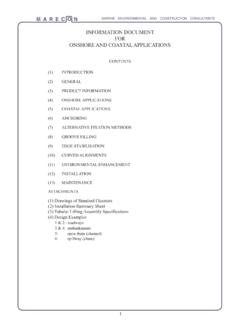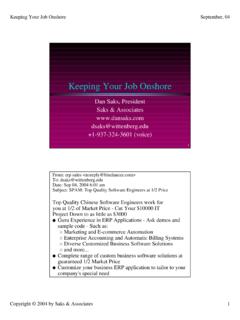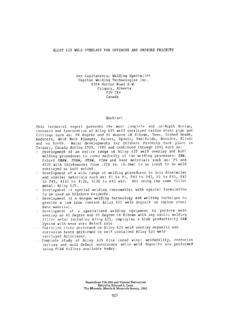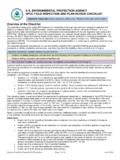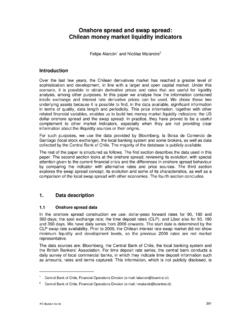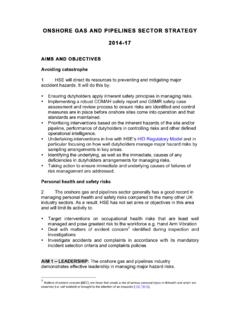Transcription of Onshore gas and pipelines sector strategy 2014-17 ...
1 Onshore GAS AND pipelines sector strategy 2014 -17 strategic context 1 This strategy sets out how HSE s Energy Division will regulate health and safety in the Onshore gas supply and pipeline industries in Great Britain. 2 The principal aim of this strategy is to prevent the release of gas or other dangerous fluids from pipelines or importation and storage facilities and so avoid injury and ill health to workers or members of the public from fires, explosions or toxic substances. 3 HSE s approach to conventional health and safety risks affecting workers are contained within other industry strategies ( construction). 4 The strategy covers what HSE will do to regulate the sector and what Onshore gas supply and pipeline operators and other industry stakeholders can do either alone or working with HSE, to maintain and improve the health and safety performance of the industry.
2 5 The matters addressed in the strategy are those that HSE, in discussion with industry and workforce representatives, has identified as key areas for improvement. 6 Deliberately, the strategy does not address every aspect of Onshore gas and pipelines health and safety. Industry is already managing some personal health and safety issues well. HSE expects industry to maintain its performance in these areas without our direct input. 7 The Onshore and offshore gas and pipeline sectors share many common challenges. In particular, approaches to ageing plant and integrity management are similar in both sectors. Additional issues specific to offshore pipelines , such as the design and maintenance of risers, flexible risers and the functionality of riser emergency shutdown valves (RESDVs) are captured in the overall approach described in HSE's Offshore Oil and Gas sector strategy .
3 DESCRIPTION OF THE sector 8 Onshore pipelines , gas and fuel storage facilities and gas importation terminals are crucial to meeting GB's energy supply needs. These vary from small gas distribution pipes operating at low pressure to large transmission pipelines conveying gas and other dangerous fluids at high pressure, including sub-sea pipelines used to import and export gas to and from Europe and Norway. Gas and fuel storage sites connected to pipeline networks also account for a significant part of the sector . 9 Gas supply failures have the potential to leave industry without energy and the public without heating. In severe winter weather, vulnerable groups could be at risk of hypothermia. Working with the Department of Energy and Climate Change and gas industry stakeholders to improve the management of any large-scale gas supply emergency is also a key strategic aim.
4 10 pipeline networks make up the GB gas transmission and distribution system for industrial and domestic consumers. This includes 278,00km of distribution mains (of which 100,000km of iron pipes are within scope of the national decommissioning programme; 7,500km of high pressure National Transmission System (NTS) pipelines operating at up to 85 barg; and 14,500km of high pressure Local Transmission System (LTS) pipelines operating at up to 38 barg. The network extends to every consumer s meter. The distribution network is operated by four key dutyholders; smaller networks are operated by independent companies. 11 Other pipelines transport gasoline, kerosene, ethylene and other industrial products and these include 1,100 km of Major Accident Hazard pipelines (MAHPs).)
5 Special duties apply to MAHP operators including a notification regime, production of a major accident prevention document and emergency plan arrangements. 12 Gas importation is via two routes. Sub-sea pipelines known as interconnectors import and export gas from and to continental Europe and Ireland and a single one-way pipeline imports gas from Norway. Liquefied natural gas (LNG) is imported via ship, unloaded, and stored at three terminals prior to gasification and injection into the transmission system. By 2020 up to 50% of GB s gas demand is expected to be met via LNG imports. 13 Gas is stored in underground cavities, salt deposits, depleted hydrocarbon reservoirs and high pressure storage 'bullets'. The use of ageing low-pressure gas holders within the gas distribution networks is now in rapid decline following agreement between HSE, Ofgem and the industry.
6 The MOD s strategically important fuel supply network of kerosene storage sites located across GB is also served by a dedicated network of pipelines . THE PRINCIPAL HEALTH AND SAFETY RISKS 14 HSE s main concern must be eliminating the risk of major hazard incidents in which many workers and/or members of the public might be killed or injured. 15 The principal risk to workers and members of the public from the Onshore gas and pipelines sector is from fire and explosion associated with loss of containment of gas or volatile fluids. The key sources of risk are ageing infrastructure, safety critical competence and leadership, third-party interference and the management of technological and structural change in the sector . 16 As the sector manages the GB gas supply, avoiding and managing risks to security of supply are high priorities.
7 Ageing infrastructure and asset integrity 17 There are six key elements to securing long-term asset safety in all aspects of the Onshore gas and pipeline sector : Initial safe design Construction and commissioning to design standards Operation within design parameters Inspection and long-term maintenance Integrity review and arrangements for managing change and decommissioning Avoiding third party damage 18 Irrespective of the nature or age of the asset, failures leading to accidents are rare events. It is therefore essential that industry develops safety performance indicators (SPIs) to ensure risks are adequately monitored and managed. The leadership necessary to ensure improvements are identified and carried forward must be in place and senior managers must be accountable for delivery.
8 19 There are two particular ageing asset issues within gas supply: Iron gas mains can fail unexpectedly leading to loss of gas and the risk of fire and explosion threatening occupied premises. HSE has worked with the GDNs to develop an iron mains risk management programme to ensure these risks are managed within the Ofgem RIIO (Revenue = Incentives + Innovation + Outputs) price review mechanism. A key risk reduction aspect of this is the replacement of iron pipes with safer alternatives manufactured from polyethylene. Gasholder failure may lead to a significant release of gas and this can give rise to a risk of fire and explosion if inappropriate developments have been allowed in their vicinity. Local planning authorities should take account of such risks and HSE makes available assistance in making these judgements.
9 The industry has been proactive in the risk reduction of aging gasholder assets. HSE has worked with industry and Ofgem to implement a successful strategy for removing holders as part of the RIIO business planning process. Safety critical competence and leadership 20 The majority of dutyholders are national and multinational companies with highly trained managers and staff. Strong leadership is required to maintain and apply skills appropriately to ensure the continued safe operation and integrity of ageing assets. The sector has also recognised that many of its most competent employees are also aging and that appropriate recruitment and knowledge transfer strategies must be implemented. 21 Many pipelines are operated by companies involved in the wider energy sector .
10 For these organisations, the challenge is to maintain adequate focus on pipeline safety. Some companies have responded by contracting out pipeline management. This increases the importance of adequate corporate oversight by these companies to maintain competence and investment. Third-party interference 22 Construction and agricultural activities can be a significant cause of pipeline failure. pipeline operators are required to provide appropriate safety information to those undertaking any form of excavation near their assets. Operators of major accident hazard pipelines also carry out regular surveillance along their pipeline routes to detect recent or ongoing unauthorised excavations. sector Change 23 Importation of LNG is expected to increase over the next decade and the challenge to the sector will be to maintain existing standards as the throughput at the existing terminals increases.











